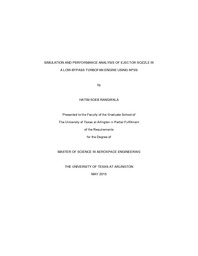
ATTENTION: The works hosted here are being migrated to a new repository that will consolidate resources, improve discoverability, and better show UTA's research impact on the global community. We will update authors as the migration progresses. Please see MavMatrix for more information.
Show simple item record
| dc.contributor.author | Soeb Rangwala, Hatim | en_US |
| dc.date.accessioned | 2015-07-31T22:10:18Z | |
| dc.date.available | 2015-07-31T22:10:18Z | |
| dc.date.submitted | January 2015 | en_US |
| dc.identifier.other | DISS-13168 | en_US |
| dc.identifier.uri | http://hdl.handle.net/10106/25108 | |
| dc.description.abstract | Nozzles for propulsive applications in airbreathing engines have long been studied to augment thrust and reduce the size of the engine. They are critical elements of the engine as they convert the internal energy into kinetic energy, thereby producing thrust. Fixed-geometry nozzles are operated optimally only at a particular set of flight conditions and are not efficient at off-design conditions. To improve off-design performance, variable geometry nozzles can be utilized which require complex mechanisms that ultimately increase weight and susceptibility to failure. Ejector nozzles provide variable geometry capability via aerodynamically varying the effective area ratios of the core and bypass flows. In addition to this, they augment the thrust of the engine by mixing the core and bypass flow, causing an increase in kinetic energy. The increase in kinetic energy is through the exchange of internal energy and momentum of the primary core flow to the secondary bypass flow in a turbofan engine. As most research codes developed by the industry are proprietary, they are not available to academia. That is why a simulation tool called Numerical Propulsion Systems Simulation is used to develop a model of an ejector-nozzle low bypass turbofan engine. A control volume approach is utilized in the formation of the ejector nozzle analytical model.Using the NPSS model, parametric optimization of bypass ratios at sea-level-static (SLS) conditions is conducted on the ejector-nozzle turbofan engine with the effect on specific thrust, specific fuel consumption, and nozzle exit area and exit static temperature. The fan and ejector bypass ratios that give optimal performance characteristics are picked for further analysis.A flight mission envelope is set for the ejector-nozzle turbofan engine that is to be compared with three conventionally configured gas turbine engines: unmixed flow turbofan, mixed flow turbofan and turbojet. At three different flight conditions of supercruise, dash and subsonic cruise, all four configurations are simulated and the performance characteristics of each engine are compared.The results from this research study should provide a better understanding of ejectors as a thrust augmenting device and is a good starting point for the simulation and performance analysis of ejector nozzles. Concluding the research study, improvements on the ejector-nozzle model developed, are discussed. | en_US |
| dc.description.sponsorship | Wilson, Donald R. | en_US |
| dc.language.iso | en | en_US |
| dc.publisher | Aerospace Engineering | en_US |
| dc.title | Simulation And Performance Analysis Of Ejector Nozzle In A Low-bypass Turbofan Engine Using NPSS | en_US |
| dc.type | M.S. | en_US |
| dc.contributor.committeeChair | Wilson, Donald R. | en_US |
| dc.degree.department | Aerospace Engineering | en_US |
| dc.degree.discipline | Aerospace Engineering | en_US |
| dc.degree.grantor | University of Texas at Arlington | en_US |
| dc.degree.level | masters | en_US |
| dc.degree.name | M.S. | en_US |
Files in this item
- Name:
- SoebRangwala_uta_2502M_13168.pdf
- Size:
- 1.647Mb
- Format:
- PDF
This item appears in the following Collection(s)
Show simple item record


